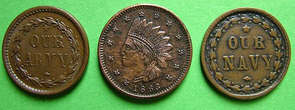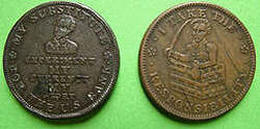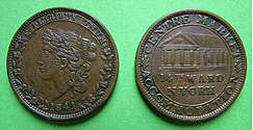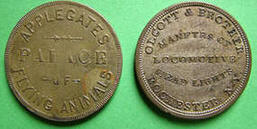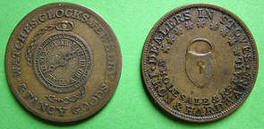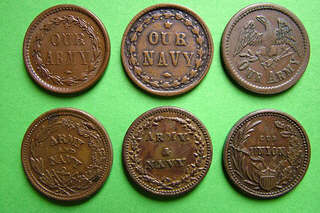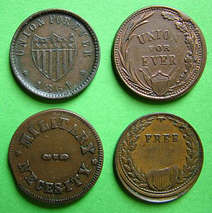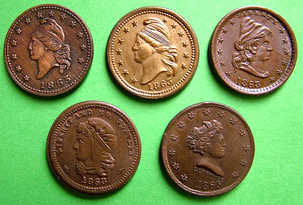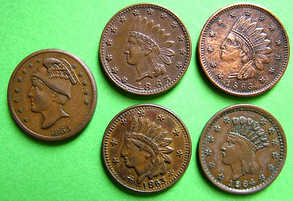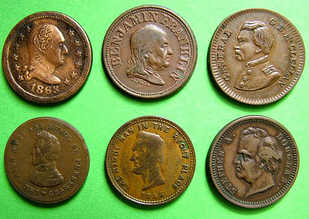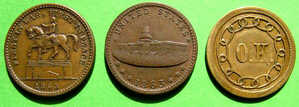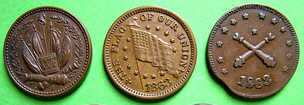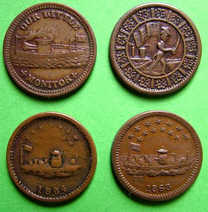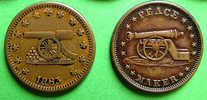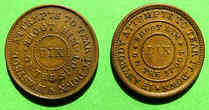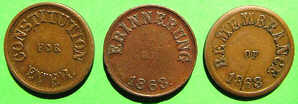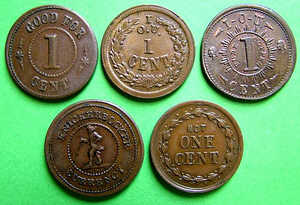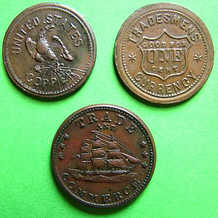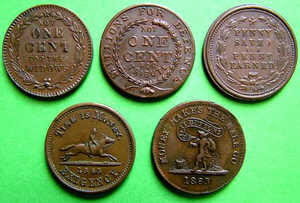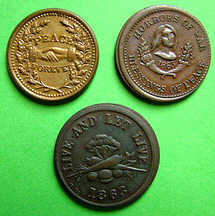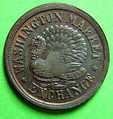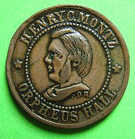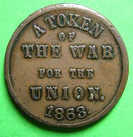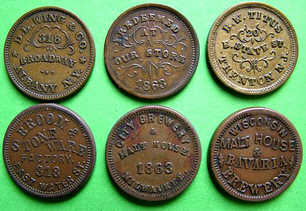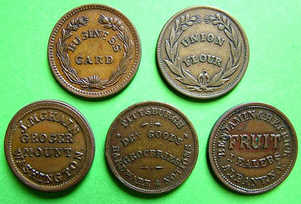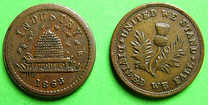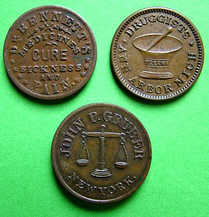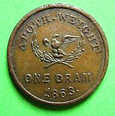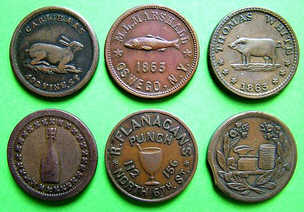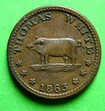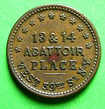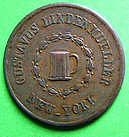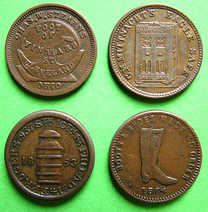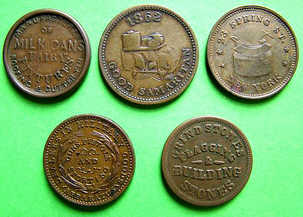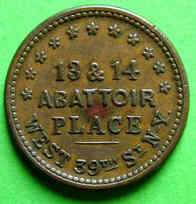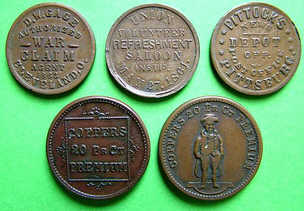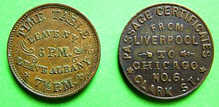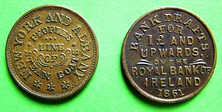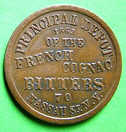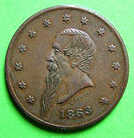PATRIOTICS AND STORECARDS: The tokens of the American Civil War
by David Powell.
Click on any image to display a double sized version.
1. INTRODUCTION.
1.1. The tokens of the American Civil War {CWTs} derive from only a comparatively short period between late 1862 and mid 1864, yet there are over ten thousand varieties representing 22 states, 400 towns and about 1500 individual merchants. They split into two categories, generally known as follows:
a. Patriotics, which are of a general nature and frequently express political sentiments. Some of these ideas are expressed in the contemptuous or satirical manner reminiscent of the US' earlier Hard Times tokens and, beyond that, the English 18th century official series now popularly known as Conders.
b. Store cards, which are issued by individual merchants and are very similar in concept and style, if not detail, to the 19th century unofficial farthing; indeed, given the large number of people who emigrated from Britain to the US in the 1840s and 1850s, one wonders to what extent the idea crossed the Atlantic with them.
1.2. The issue of these tokens was brought about early in the Civil War by its economic consequences. The Union government's first attempt to resolved the crisis was to issue unsupported paper money, followed briefly in mid-1862 by the issue of postage stamps in small protective containers (!!); then, when these both failed, it fell back on the solution adopted by the British so widely during the Napoleonic era. In other words, let everybody issue and use tokens until the matter could be got under control. Manufacturers commonly charged their clients 73 cents per hundred pieces.
1.3. The period of striking of CWTs was actually quite short, from late in 1862 until Q2/1864 when Congress passed two acts forbidding their issue by either firms or individuals. Possibly their use continued a short while longer. Pieces with dates just prior to the CWT period do occasionally occur, but these arguably belong to the Compromise Era which fits between the Hard Times Period and the Civil War.
An approximate distribution of dates might be something like:
1862 1% 1863 61% 1864 7% Undated 31% Other few
One manufacturer, S.D.Childs of Illinois, commonly used the date 1861 on his storecards, but it is debatable whether it is correct.
1.4. The vast majority of these pieces, particularly the commoner ones, are copper or brass pieces of the same size as the contemporary small cent, recently introduced in the mid- 1850s; some of them actually state that they are cents, although the majority do not. There are however, a significant number of pieces which are of different value, size or metallic structure, although for the most part these are quite rare. The alternative values, which were usually larger and of a more silvery appearance, were 10c, 15c and 25c; usually for sutlers' tokens, discussed under Store Cards below. Most cents are 19-20mm in diameter, although copper up to 27mm is seen. Some of those in the 24-27mm range which are undated may well be earlier pieces dating from the Compromise Era a few years earlier, during which larger pieces were the norm; after all; as in British numismatics some series merge, and the cataloguers of one place some pieces in the adjacent. There are, indeed, some issuers whose names appear in both the Compromise and CWT series.
1.5. George and Melvin Fuld, in their two standard works on this series, identify some thirty- odd die-sinkers, mostly but not always anonymous on their pieces, whose work can be often be identified by their style. Because of the vastness of the US, there is a little more distribution of manufacturer than with the British series, although New York, Waterbury {Connecticut} and Cincinnati {Ohio} predominate. A crude count using Fuld suggests that approximate percentages of the manufacture for these locations, in terms of type rather than volume, might be something like 52%, 16% and 11 % respectively.
1.6. In Britain we see very little of the CWT series, except for a few of the commonest pieces in junk trays. These usually depict the words "Our Army", "Our Navy" or the like in a wreath. These celebrate the loyalty of the army and navy, unintentionally aping the Fides Militum sentiments of the Romans some 1600 years earlier.
2. CATALOGUING AND TERMINOLOGY.
2.1. Like the British 18th century series, the commoner patriotic pieces have a lot of die varieties which are extensively muled to an extent which most collectors decide not to bother with. A side with a head on is more generally considered to be an obverse, whereas one with a wreath on is a reverse; however, there is no hard and fast rule. With store cards, a simple listing of varieties ordered obverse first will suffice, because only one side is patriotic. When both are patriotic, there is a rough pecking order as to which is considered dominant {i.e.the obverse}, and it is necessary to have both obverse- and reverse-oriented cross-reference lists; which Fuld duly gives.
2.2. For those patriotics which have more than one die, Fuld divides them into some sixty-odd named families and then provides for each a die-a-gram which considerable eases the identification of individual dies. The name may sound corny but the concept is very useful. These represent most of the major themes, but equally there are a number of others, of no less relevance or interest, for which a single die suffices. Fuld numbers both families and individual dies; adverts and other references frequently just quote die combinations in the form "F.mmm/F.nnn", and perhaps little else.
2.3. I mentioned the term "Store Card" as being odd; there are some others. "Business Card" means the same thing, and these terms are occasionally seen on the reverse of pieces; typical, within a wreath. The other strange term is "medal", which is an occasional Americanism for "token". It does appear to be just a synonym, and you must sometimes forget the British sense of the word to remind yourself that a piece bearing it was for use, not ornament.
3. PATRIOTICS.
3.1. Manufacturers mass-produced generic CWTs for use by those who did not want the additional expense of setting up dies for specific orders, whilst always being willing to tailor their products to the needs of those prepared to pay extra for personalised advertising. The generic CWTs had to have some theme, and although most pieces carried slogans that were often pro-Union, or occasionally against it, many were politically neutral. Pacifist themes were, for example, sometimes seen. For numismatic purposes, however, all these stock pieces are known as patriotics regardless of their subject matter, probably because that sentiment predominates.
3.2. Patriotics depict a relatively small number of common themes. First in sequence are the heads, of which there are about eleven, commencing with the turbanned head as attributed variously to the three major engravers Levett, Glaubrecht and Sigel, followed by several mythical heads which borrow from or foretell the main US coinage, and winding up with several which depict major US personalities of the period: McLellan, Franklin, Jackson, Lincoln, Douglas and others.
3.3. Next follow a group which depict these same gentlemen on horseback, or other symbols of the Union; shields, eagles, flags and the like, or even the presidential palace, usually festooned with patriotic sentiment.
3.4. A third group depicts some of the equipment of warfare; cannon, the US Monitor {the Union's naval flagship}, or a selection of infantry equipment. One version of the cannon, with a pile of balls at its feet, is very much a stereotype; but the other has a marvellously expressive look and tells the world, somewhat cynically but in no uncertain terms, exactly what some thought the answer to the nation's problems was. If any coin can be said to convey grim humour, Fuld 169 takes some beating.
3.5. A fourth, non-pictorial, concentrates on statements of patriotic policy or belief alone: "The Federal Union: It Must and Shall Be Preserved", "If Anyone Attempts to Tear It Down, Shoot Him on the Spot". The latter die, known as a Dix after the general who uttered the sentiment, is invariably paired with the Union flag.
3.6. The last major loyalist group is those with very short phrases, usually within a wreath, such as "Our Union", "Our Country", "Union For Ever", "Constitution for Ever" or "Remembrance of 1863". A German version of the last-mentioned exists, "Erinnerung am 1863", and also occurs paired with store card obverses, for use by the large population of that origin; not that foreign language appears much otherwise on the series, although one tradesman uses the Hebrew word for "Kosher" on a storecard, which commands a premium in consequence.
3.7. One of the more common neutral Patriotics commemorates Diedrich Knickerbocker, the fictional author of Washington Irvine's "The History of New York", whose name is now better known in connection with ice cream. Others are more innocuous, stating simple things like "Good for 1 Cent", "IOU One Cent" or "US Copper" {implying the stability of the latter}; whilst other, by way of explanation, contain the simple statement "Business Card" or "Store Card" within a wreath. One deceptive piece is that depicting Lincoln on one side and "OK" on the other, implying that the country will do well under his leadership; less known is that "OK" stands for "Ole Kinderhook", the nickname of Lincoln's political ally Martin van Buren, called after the town in New York state in which he was born, and that thus a common piece of slang has come into our language.
3.8. A number of pieces retain those sentiments from the earlier Hard Times tokens of 1837- 41 which convey an undercurrent of rebellion; one is not always sure whether the speaker is making a statement of belief or being satirical: "Money Makes the Mare", "Millions for Contractors", "Millions for Defence", "Not One Cent for the Widows", "Time is Money", "Penny Saved is Penny Earned".
3.9. The peace movement gave rise to a small number of tokens: "Horrors of War, Blessings of Peace", or "Live and Let Live"; the latter piece depicts a pile of vegetables on one side and a turkey, which was Benjamin Franklin's preference over the bald-headed Eagle as a choice of national symbol, on the other. Also included in this group is a clasped-hands piece of the type so beloved by the Romans, in this instance inscribed "Peace Forever" amidst a wreath.
The amount of pacifist sentiment was somewhat limited, however, with many people having very different opinions as to how peace was best obtained; as Fuld 169, discussed in para 3.4 above, so amply illustrates.
3.10. There were also a small number of pieces which are CWT-like in appearance but which are thought to have been issued for political purposes with no intention of circulation. Nearly all of them issue from the Cincinnati makers and depict larger than usual portraits of the individuals involved. Effectively they are the equivalent of the Skidmores in the Conder series. There is also one which merely states, "A Token of the War for the Union", without any other statement of allegiance or attribution.
4. STORE CARDS.
4.1. The term "Store Card" appears at first glance a horrible misnomer. Today, it would suggest plastic; earlier, it would suggest a cardboard visiting card. Except that it isn't made of card, however, the CWT is basically a combination of the two; a metal visiting card, which is allowed or assumed to have some value. Virtually all bear the name and most the address of the issuer, as per the British unofficials of a few years earlier, and; many look little different. Certain of the makers, such as the one responsible for several of the commoner New York pieces, have their own distinctive style of lettering.
4.2. The wreath continues to be popular, and some pieces state their purpose within in very simple terms. The range of inscription within it, however, is varied and interesting; for example "Business Card"and "Store Card" are both frequent, whilst other more curious expressions such as "Union Flour" are also sometimes seen.
4.3. The term "Half Card" is often used as a generic term for tokens which have one specific side and one patriotic; i.e. where the issuer commissioned his manufacturer to design something specific for one side, but was quite happy to take anything the latter offered him for the other. In the latter case, the second side would inevitably be one of that manufacturer's stock, i.e. patriotic, designs. Where this happens, the store card design is regarded as the obverse and the patriotic as the reverse, regardless. Half Cards will, however, be found listed in the Store Card category.
4.4. Of the pictorial reverses, there are just one or two borrowed from British originals; the Scottish thistle, and the beehive of industry, are familiar enough to those who collect pieces from this side of the water.
4.5. The trades represented are to some extent not dissimilar to those featured on the British 19th century unofficial series, although one feels that the range is slightly wider, with possibly a little more emphasis on the practicalities, e.g. hardware, needed to set up home and business in a developing country. For example, one feels that grindstones, saws, garden rollers, safes and fishing tackle are subjects which one would be slightly surprised to find mentioned in the UK series; even if the fishing tackle proprietor did double up as a professional numismatist! There are kettles, but not so many tea dealers; at Pittsburgh, Pennysylvania, there was already a dealer in mineral water, which one might think more of a late 20th century fad. The stove is a common reverse, and several different designs are in evidence. Finally, spare a thought got the poor pig depicted on the obverse of butcher Thomas White's piece, who might be feeling a little uncomfortable if he could read the reverse, advertising his master's premises at 13-14 Abattoir Place!
4.6. Certain very specific advertisements include some related to the war interest: a few Philadelphia pieces relate to Union Recruitment Fairs, and a number of war agents, concerned with making a living out of the financial logistics of the times, feature amongst the other tradesman. On a lighter note, one common piece of unusual type was issued by the company which ran the New York to Albany Ferry, and what more appropriate to depict on the two sides than the timetable!
4.7. There are a number of interesting oddities. A picture
of a praying monk and a running elephant are presumed to refer to the names
of the establishments which they represent, as the name on the reverse in
one case confirms. Occasional pieces double up as weights, depicting a scale
on one side and an apothecary's value on the other, whilst amongst the oversize
pieces are Matthews Medal, which hints at early Greek coin design, and another
piece which appears to depict a US version of Britannia.
5. OTHER FEATURES, COMMON TO BOTH SERIES
5.1. There are over thirty known dies sinkers, some of whom have distinctive styles; for example the Rhode Island die-sinker, name unknown, who uses lower case lettering, or Marr of Milwaukee, who enjoyed a near-monopoly of Wisconsin's issues. A number, such as the three prolific New York die-sinkers Sigel, Horter and Roloff, sometimes put their full names or initials on the tokens; but for the most part the pieces are anonymous, leaving one with an interesting game of trying to find out, from the die-links with those which are signed, and from the general style, where the rest came from. Some die sinkers are common on patriotics but rare on storecards, or vice versa.
5.2. There are amongst the CWT series a high number of defective manufactures, where either a curved segment is missing from the piece or where there is a raised "cud". Offstrikes are also slightly commoner than in most machine-produced series. There are also a number of notable die-cutting errors, mostly letter-transpositions {e.g. "ni" for "in"} and other simple spelling mistakes; Fuld lists nine in the Patriotic series, and there others on the storecards. The most famous one concerns the Unionist General Dix's quotation, "If anyone attempts to tear it" {meaning the Union flag} "down, shoot him on the spot". Most specimens of this common piece quote the phrase as stated, but there was one die- sinker who, having got the double-"O" right in "shoot", then repeated it in "spoot". Such pieces are fancied, and always fetch a little more than their normal couterparts.
5.3. Some dealers and collectors like to read significance into minor die varieties, of which there are many, in much the same way that Dalton and Hamer exhorts us to do with 18th century Conders; however, as with that series, many of us choose to ignore them. Likewise with cuds and defectives. There was even one manufacturer, Higgins of Indiana, who produced dies which were "hubbed" from one of his rivals'; that is, stamped from a matrix made with another die. These pieces are often poorly struck up, and infrequently found in better condition.
6. SUTLERS' TOKENS
6.1. Loosely allied to the Store Card series are a series
known as Sutlers' tokens. A sutler was an itinerant vendor of the same type
as those who issued store cards but who, instead of setting up shop in one
place, got his business by following the army around and selling to it wherever
it went. They tend to be rarer, less regular in size and metallic content,
fairly plain in design, and highly variable in face value; although because
of this, the value is nearly always stated, rather than assumed. The nearest
equivalent in English paranumismatics is probably a value-stated check or
a market token.
7. GEOGRAPHIC DISTRIBUTION.
7.1. Like the British series also, there are some places
which feature as being strong issuers and users, and others not; likewise,
the manufacturers are also seem to be confined very much to certain major
cities. The chances were that, if you lived east of the Mississippi River
in a state that remained in the Union, there was a business in your area
that issued Civil War tokens.
7.2. Some figures
derived from Fuld on the approximate distribution of Store Cards:
Towns Items Issuers %
Ohio 103 3173 465 36.87 New York 24 1468 148 17.06 Michigan 55 1298 254 15.08 Indiana 69 702 198 8.16 Wisconsin 46 526 189 6.11 Pennsylvania 12 339 58 3.94 Illinois 33 333 110 3.87 Other {16} 49 768 8.92 TOTAL 391 8607 1515 100.00
and on the makers of Patriotics; one presumes that the two series are geographically similar:
Makers Pieces %
New York NY 10 232 52.5 Cincinnati Ohio 5 51 11.5 Philadelphia PA 4 41 9.3 Chicago IL 2 6 1.4 Waterbury Connecticut 2 72 16.3 Baltimore Maryland 1 2 0.5 Hillsdale Michigan 1 4 0.9 Milwaukee Wisconsin 1 5 1.1 Mishawaka Indiana 1 21 4.7 Rhode Island Rhode Island 1 9 2.0 TOTAL: 31 443 100.00
It will be noticed that there are no known cases of two manufacturing centres occurring within the same state.
8. RARITY.
8.1. Like the British 19th century unofficials, many CWTs do not exist in great numbers, and would greatly increase in value if many gravitated to them. Fuld attempts to grade the rarity of all pieces on a scale of R-1 {common} to R-10 {probably unique}, and reckons that nearly 80% are R-7 or higher. Never mind, that still leaves 2000+ for those wanting to build a sample collection from the remainder, which is several times the choice available for 19th century unofficials. Sutler tokens are R5 minimum.
8.2. The total number of pieces issued is thought to
be of the order of 25 million, the commonest being the million or so store
cards issued by the distinctive long-bearded Gustavus Lindenmueller of New
York. It was possibly his mocking refusal to redeem his tokens, amongst
others, which prompted Congress to put an end to the series in 1864.
9. REFERENCES:
9.1. The main works are:
George & Melvin
Fuld: Civil War Store Cards {1982}
George & Melvin Fuld: Patriotic
Civil War Tokens {1975}
David E. Schenkman: Civil War Sutler Tokens and
Cardboard Scrip {1983}
The almost universally-used Fuld books
have been recently supplemented by the "Civil War Token Price Guide"
by Byron Kanzinger {2002}, the sole purpose of which is to put values against
the rarity indications supplied by Fuld.
9.2. The term "Store Card" is also used at an earlier date than the Civil War, and there are other books, such as Edgar H.Adams' "United States Store Cards" which refer mostly to the period between the Hard Times and Civil War periods rather than to the Civil War itself. This period is sometimes known as the Compromise period.
9.3. A active Civil War Token Society exists and produces
its own quarterly Civil War Token Journal, very much along the lines of
the Token Corresponding Society in Britain.
